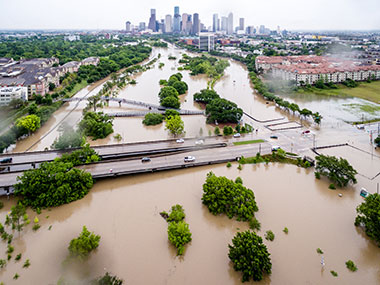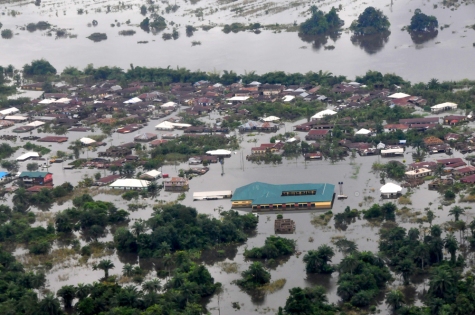|
one-balled nipple jockey
Join Date: Dec 2010
Location: Dirty Souf Biatch
Posts: 22,033
|

Before the Flood
Soundtrack album by Atticus Ross, Gustavo Santaolalla, Mogwai, and Trent Reznor

Quote:
millions have been left homeless following devastating floods that have hit India, Bangladesh and Nepal, in one of the worst flooding disasters to have affected the region in years.
International aid agencies said thousands of villages have been cut off by flooding with people being deprived of food and clean water for days.
|
Quote:
More than 700 million people in India, Bangladesh and Pakistan get there water from rivers that come from the Himalayan glaciers.
That’s more than twice the population of the US getting its water from, at root, a singular source.
These glaciers, like others in the world, are at risk of melting because of increasing temperatures and erratic weather patterns. Glaciers depend on heavy precipitation to replenish ice on an annual basis. As monsoons in India are disrupted, ice vanishes.
As the glaciers melt, rivers flood. As rivers flood, people, crops and livestock drown and hydroelectric plants are disrupted. And the weaker monsoons mean less rainfall for the country as a whole, which means drought. Over time, of course, melting glaciers means less flowing water in general--so more drought.
There are 198,000 glaciers in the world. India contains about 9,000 of them
|
Quote:
So far, the results have been positively chilling. When President Taft created Glacier National Park in 1910, it was home to an estimated 150 glaciers. Since then the number has decreased to fewer than 30, and most of those remaining have shrunk in area by two-thirds. ***re predicts that within 30 years most if not all of the park's namesake glaciers will disappear.
"Things that normally happen in geologic time are happening during the span of a human lifetime," says ***re. "It's like watching the Statue of Liberty melt."
|
Quote:
And it has shown precisely that the sea, of course, is not actually level. It varies as much as six feet (two meters) from place to place. And it is not rising evenly, like a bathtub filling with water. Currently, regional differences in sea level rise are dominated by the effects of ocean currents and natural cycles such as the Pacific Ocean's El Niño phenomenon and Pacific Decadal Oscillation. As the ice sheets continue to melt, scientists predict their meltwater will overtake natural causes as the most significant source of regional variations and the most significant contributor to overall sea level rise.
Or as Willis put it: "You ain't seen nothing yet."
“Given what we know now about how the ocean expands as it warms and how ice sheets and glaciers are adding water to the seas, it’s pretty certain we are locked into at least 3 feet of sea level rise and probably more,” said Steve Nerem of the University of Colorado, Boulder, and lead of NASA's new Sea Level Change Team.
Greenland’s summer melt season now lasts 70 days longer than it did in the early 1970s
The waters of the Southern Ocean are layered: on top and at the bottom, the temperatures are frigid, but the middle layer is warm. The westerlies, the winds that spin the ocean waters around Antarctica, have intensified during the last decade, pushing the cold top layer away from the land. This allows the warmer, deeper waters to rise and spill over the border of the continental shelf, flowing all the way back to the base of many ice shelves. As the ice shelves weaken from underneath, the glaciers behind them speed up.
|
Quote:
|
Miami Beach to begin new $100 million flood prevention project in face of sea level rise
|
Quote:
CLIMATE
Was the Extreme 2017 Hurricane Season Driven by Climate Change?
Global warming already appears to be making hurricanes more intense
By Annie Sneed on October 26, 2017
Was the Extreme 2017 Hurricane Season Driven by Climate Change?
Summer and fall 2017 saw an unusual string of record-breaking hurricanes pummel the U.S. Gulf Coast, eastern seaboard, Puerto Rico and the Caribbean.
Hurricane Harvey brought unbelievable floods to Houston. Irma, one of the two strongest hurricanes ever recorded in the northern Atlantic, wreaked havoc on Florida and many Caribbean islands. Maria devastated Puerto Rico and the Virgin Islands. The destruction begs the question: Has climate change influenced these extreme events? Hurricanes can be difficult to decipher, but experts are gaining a sense of what our warming world might mean for monster storms in the U.S. and worldwide.
STORM INTENSITY
Many experts are confident that a warmer world will create stronger storms—and already is doing so. Since 1981 the maximum wind speed of the most powerful hurricanes has risen, according to research (pdf) by Jim Elsner, a climatologist at The Florida State University. That’s because higher ocean heat provides more energy for storms, fueling their intensity. Hurricane Patricia, in 2015, set the record at the time for top wind speed—215 miles per hour—in the north Atlantic. The next year Winston shattered records as the most intense cyclone in the Southern Hemisphere
|





|